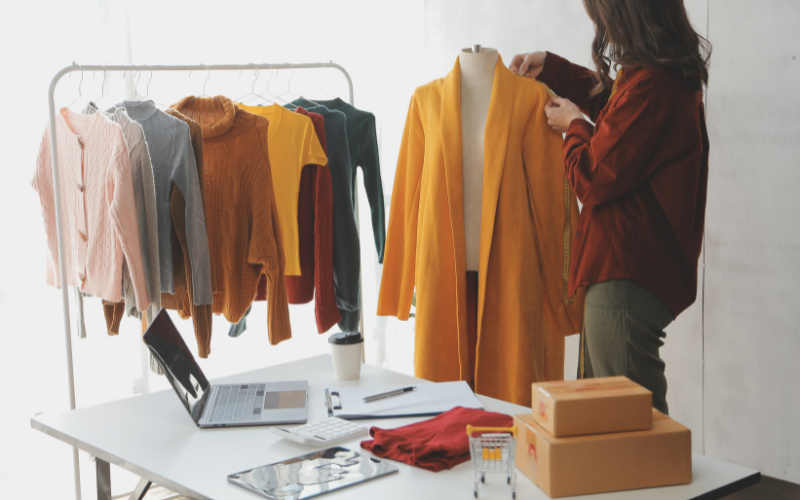
Exploring the Latest Trends and Innovations in the Fashion Industry
Fashion design represents an ongoing creative process that consistently adapts to shifting consumer tastes and technological advancements. As we embark on a new era of fashion, designers rigorously explore cutting-edge trends and innovations to develop distinctive and captivating design concepts that resonate with consumers. The fashion industry is wholeheartedly adopting novel ideas, from sustainable materials to digital design tools and augmented reality technology, ultimately expanding the parameters of what can be achieved in the realm of fashion design.
As the renowned fashion designer Karl Lagerfeld once said, “Fashion is not about looking back. It’s always about looking forward.” This statement is accurate as designers seek new ways to innovate and experiment with new materials and technology.
This blog will explore the most recent fashion design trends and developments, analyzing how designers utilize cutting-edge technologies and methods to produce snipping designs that reflect customers’ ever-evolving tastes.
#1 Circular Fashion: Rethinking Sustainability in Fashion.
The emphasis on sustainability has been one of the biggest trends in the fashion industry in recent years. Fashion designers are reacting to consumers’ growing awareness of the environmental effect of purchasing things by investigating sustainable materials. Using recycled materials is one of the most exciting advancements in this field. From upcycling antique garments to producing new fabrics from recycled plastic bottles, fashion designers combine recycled fabrics and materials to create unique and beautiful creations.
The usage of organic materials is a trend sustainably. For instance, organic cotton is farmed without toxic pesticides and is more environmentally friendly than conventional cotton. Alternative materials are also becoming more popular, like hemp and bamboo.
#2 Digital Design Tools: Shaping the Future of Fashion Design
Fashion designers can now make sophisticated and unique designs that would have been difficult to make using conventional techniques. As the famous designer, Donatella Versace, said, “Technology pushes boundaries, it makes things new, it’s always forward-thinking.” Digital tools have enabled designers to bring their wildest ideas to life, allowing them to experiment and refine their designs easily.
Designers can swiftly produce digital drawings and fine-tune their ideas using Adobe Illustrator and CorelDRAW programs. The accuracy offered by digital tools also makes designing elaborate patterns and embellishments for clothes simpler. There are countless possibilities, and as technology develops, the fashion industry will keep evolving and expanding the realm of what is feasible.
The creation of fashion prototypes is also changing thanks to 3D printing technologies. Now that actual models of designs can be made fast and readily, designers are able to test and improve their ideas in ways that were previously not conceivable.
#3 Wearable Technology: Merging Fashion and Functionality
The fashion industry has already greatly benefited from the relatively recent discovery of wearable technology. This technology combines Fashion and practicality to produce apparel and accessories that are both stylish and functional. Smartwatches, activity trackers, and even garments with integrated sensors are all examples of wearable technology.
As the athletic trend has grown, wearable technology has gained momentum. Designers are looking at new methods to incorporate technology into their creations to provide more valuable and practical apparel.
#4 Personalized Fashion: Customization and Personalization in the Digital Age
Consumers want distinctive and customized experiences in the digital era, and the fashion business is no different. Customers can develop unique designs that represent their own tastes and style thanks to personalized Fashion. This style covers a wide range, from made-to-measure designs that are fitted to the customer’s body to customizable apparel and accessories.
Technology developments have increased the availability and affordability of customized Fashion, enabling designers to produce customized designs for clients worldwide.
#5 Slow Fashion Movement: Reimagining Fashion’s Relationship with Time
The fast fashion business, which quickly turns out inexpensive, throwaway apparel, is the target of the slow fashion movement. Slow Fashion promotes ethically made and supplied sustainably clothing by emphasizing quality over quantity.
The campaign is a call to action for shoppers to buy less and spend money on durable, high-quality apparel. Craftsmanship is a priority for slow fashion designers, who use time-honoured methods and eco-friendly materials to make clothes that last a lifetime.
#6 Artificial Intelligence and Machine Learning: Advancements in Fashion Retail and Production
Artificial intelligence and machine learning advancements have revolutionized the fashion industry, from retail to production. AI-powered algorithms can
analyze data to predict consumer trends and preferences, helping designers create clothing that resonates with their target audience.
AI is also being used in the production process to streamline and automate manufacturing, reducing production times and costs. With the help of AI, the fashion industry is becoming more efficient, sustainable, and innovative.
#7 Augmented Reality (AR) Technology: Creating Immersive Fashion Experiences
Augmented reality (AR) technology in fashion design is another fascinating trend. With augmented reality (AR) technology, designers can build virtual shopping experiences that let customers interact with and try on virtual clothes and accessories.
The usage of virtual try-on technology is one example of this, which enables customers to view how apparel or accessories will appear on them without really trying them on. This technology is gaining popularity, especially in the online retail industry, enabling customers to make better-informed purchases.
Virtual fashion shows are another way AR technology is used in fashion creation. Designers can use augmented reality (AR) technology to build virtual, immersive fashion experiences that let viewers explore their designs in 3D from any angle.
Wrapping Up
Designers continually investigate new trends and breakthroughs as the field of fashion design is constantly changing. The fashion industry is adopting new concepts and technologies that alter how we think about clothes, including repurposed materials, digital design tools, and augmented reality technology. It will be interesting to watch how designers continue to push the limits of what is
possible in fashion design as consumers continue to demand more sustainable and inventive items.
With the help of the International College of Fashion, we will gain a deeper understanding of the impact of these trends on the fashion industry and how they are shaping the future of Fashion. Join us as we delve into the world of fashion design and explore the latest trends and innovations shaping the industry today. Take advantage of this exciting opportunity to expand your knowledge and stay ahead of the curve in the world of Fashion.



